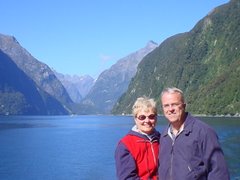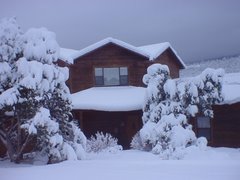Here are a river scene and a campground shot. Lots of tall cottonwood trees to provide shade and pleasant sounds as the wind blows through them.


Anyhow, after we got to Billings late Friday morning, 7/10, after a grueling 60 mile drive, I went downtown for a history walk, which led to an interesting connection. When we visited with my classmate, Ken Tiahrt, a few days earlier in Bozeman, he had mentioned his interest in old highways, in particular the Yellowstone Trail. That highway came up in my history walk and then the tour guide pointed out this marker for another named highway, the Glacier to Gulf Motorway.

That highway ran from Brownsville, TX to Calgary, Alberta, with a spur from Galveston. These named highways were established soon after automobile travel became popular, before the government came up with numbered highways in the 1920s.
I sent Ken this picture. He wrote back that I had made his day. A great discovery for Montana car buffs. He would post it on his old car club's website and acknowledge me for its discovery. Ain't history fun.
Our main reason for coming to Billings was to visit the Little Bighorn Battlefield, located about 60 miles SE of Billings. We went there Saturday. Started with a bus tour put on by students from Little Big Horn College. Our guide was great, very dramatic. She made us feel like we were there on the battlefield, trapped between soldiers and warriors. (I should note that the National Park Service on its website sniffs that they cannot vouch for the accuracy of presentations by organizations other than themselves. Our guide said there are 5000 books on the battle and none of them agree. Nobody in Custer's immediate command survived to tell the story, so there is room for much speculation.)
Here's the hillside site of Custer's Last Stand.

When troops from another cavalry force came on the scene a day after the battle (which was June 25, 1876) they marked the locations of the bodies they found in this horrific scene - more than 200 deaths. The marker with a black shield is Custer's. The bodies were initially buried where they were found. Subsequently they were disinterred and some 220 soldiers who died here are buried in a mass grave at the top of the hill from where this picture was taken. Bodies of the officers were moved elsewhere, including Custer who is buried at West Point.
Here's the memorial to the soldiers, and some civilians, who died on this battlefield.

The Little Bighorn River is in the valley below. That's where there was an encampment of around 8000 Indians from various tribes, 2000 of them being warriors. Custer, with his force of 600, was either unaware of how large the force opposing them was or was overconfident in their ability to defeat it.
In 1997 this Spirit Warrior memorial to the Indian warriors in the battle was added to the battlefield displays.

It was a very somber thing to be here. You ask Why? and How (could things have been handled differently)? but no satisfactory answers come.
Returning to Billings, we made our last stop on the Lewis and Clark trails. Pompeys Pillar is a prominent outcropping on the banks of the Yellowstone River about 20 miles east of Billings. Clark and his party stopped there on their return journey -- it's recorded in Clark's journal. He said he wrote his name and the date there and there it is - the first graffiti west of the Mississippi?


The rock was named for Sacagawea's son, who made the whole trip. Pompy was the boy's nickname and Clark actually called this place, Pomp's Tower. When you google Pompeys Pillar you get a pillar in Alexandria, Egypt, as well as this National Monument in Montana .
Here's a view of the river from the top of the Pillar. A board stairway has been constructed which gets you to Clark's signature and to the top.

Hail and farewell to you, William Clark.

We had planned to leave Sunday noon, after church, to head south through Wyoming. However, the campground was practically deserted, a pleasant breeze was blowing, there was no one in the swimming pool, and we didn't have a need to rush, so we stayed another night. Was a blissful, totally relaxed afternoon -- no agenda, no place to go.
In late afternoon, while we were dining at Cracker Barrel, a strong thunderstorm went through the area. At the KOA it knocked out power and blew down a few limbs, but there was no damage. There was a prominent rainbow as we drove back to the KOA. This is what remained by the time I got my camera out and clambered up the river bank.

Cheers,
Susie and Rob







1 comment:
I would love to use your picture of the Glacier to Gulf sign on my website www.1922coast2coast.com. I'll be glad to give any citations needed.
Claire
Post a Comment